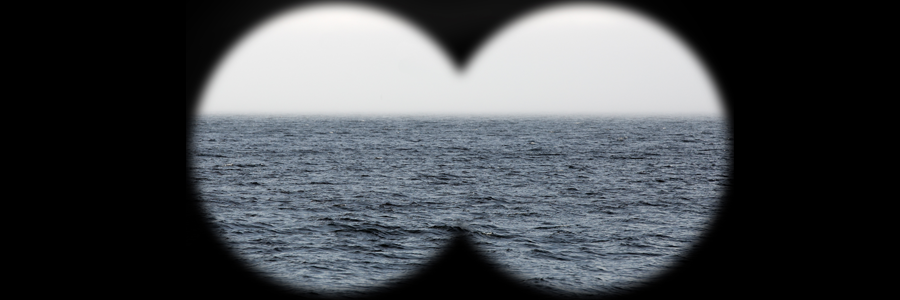
Fog at sea seen through binoculars (Photo credit: Wiklander)
In this age of artificial intelligence, self-driving cars and autonomous ships, the word 'lookout' would appear to sound outdated or even irrelevant. On the contrary however, the role of the 'lookout' on board ships remains more important than ever given the increasing traffic volumes at sea and the more complex equipment being used in integrated bridge systems. It is for the watchkeeper to understand the limitations of the equipment available to them and decide what means they must use to properly determine the risk of collision.
There is perhaps no better way to explain this function of watchkeeping, than as it is set out in Rule 5 of the collision regulations:
"Every vessel shall at all times maintain a proper look-out by sight and hearing as well as by all available means appropriate in the prevailing circumstances and conditions so as to make a full appraisal of the situation and of the risk of collision"
The watchkeeper must be able to adapt to the prevailing traffic, weather and visibility conditions and use all the resources available to him to assess whether or not a risk of collision exists. For example, in open sea and good visibility conditions, a visual sighting followed by a series of bearings would provide the watchkeeper a reliable indication as to whether a risk of collision exists as described in Rule 7. Change the scenario to poor visibility and multiple targets and the lookout's role has suddenly become a lot more challenging. Of course, the increased number of aids to navigation such as ARPA, AIS and more recently the ECDIS has provided the watchkeeper with an additional aid to determining if a close quarter situation is developing or if risk of collision exists. The watchkeeper should use a combination of both plain sight and all other available aids to navigate safely. There is a danger that over reliance on electronic aids can become common and the watchkeeper will rely solely on these without looking out of the bridge windows. Is the officer on watch aware of the limitations of the equipment? Is he or she confident to make an evaluation of the circumstances and conditions and make the right decisions?
The effect of technological advancements on board ships ultimately can be measured in the number of accidents that occur at sea. Unfortunately, despite the bridge systems becoming more advanced, collisions and groundings still occur. Whilst there are a number of reasons an incident may occur the majority of all incidents remain attributable generally to human error. These human errors can range from fatigue to inadequate training or even poor communication skills. These topics have been researched and discussed industry wide however the Club would like to draw our Members' attention to an additional issue. That is the increased use of personal electronic equipment that if used during watch hours will affect the watchkeeper's ability to carry out his bridge duties effectively.
It is common that people today own and travel with laptops, mobile phones and gaming consoles, and it is not surprising that these devices find their way onto the vessel for recreational use during free periods. However, if such devices are being taken to the bridge this can cause a lack of concentration to the primary role of the watchkeeper and potential hazardous situations.
In a recent collision involving a merchant vessel and a fishing vessel which resulted in loss of life, it was revealed that a movie was playing on the bridge for the most part of the watch before the incident occurred. It was clear from the VDR that this distraction had interfered with the watchkeeper's ability conduct an effective lookout. In another similar incident, the VDR revealed loud music playing in the background in the run up to the incident which again is another distraction to watchkeeping.
It is possible that near misses have occurred due to similar practices. Therefore we would like to highlight to our Members the importance of implementing clear procedural guidelines that prohibit the use of any personal electronic equipment on the bridge during watch-keeping hours. It is beneficial that these requirements are frequently reinforced during training sessions to ensure that they are complied with by all. The watchkeeper must understand that their undivided attention is required throughout the period of their watch and right up until the time that the watch is handed over.